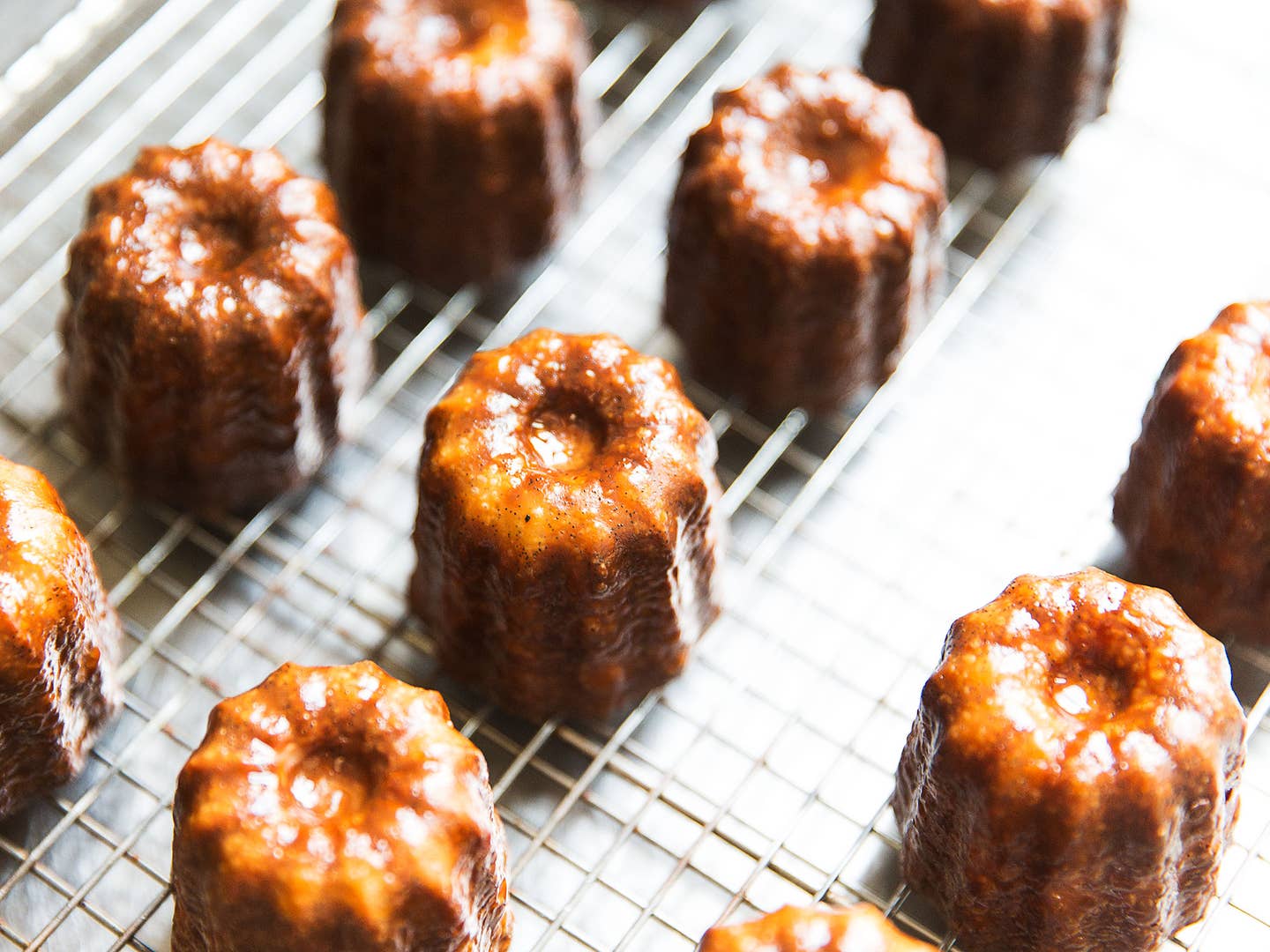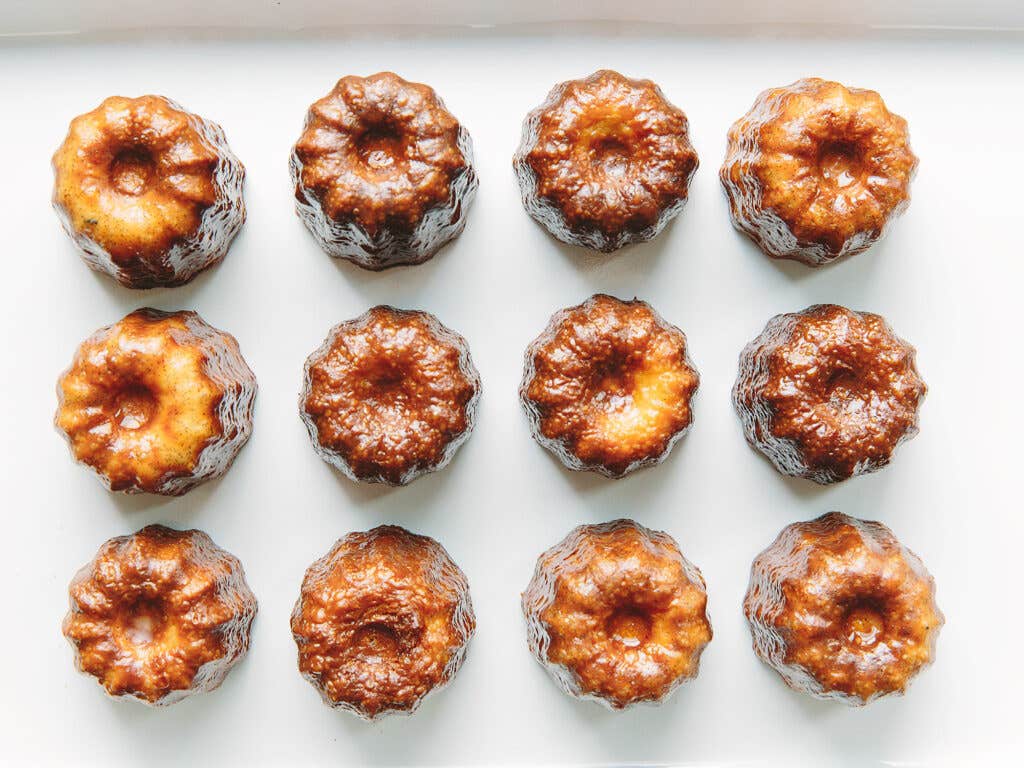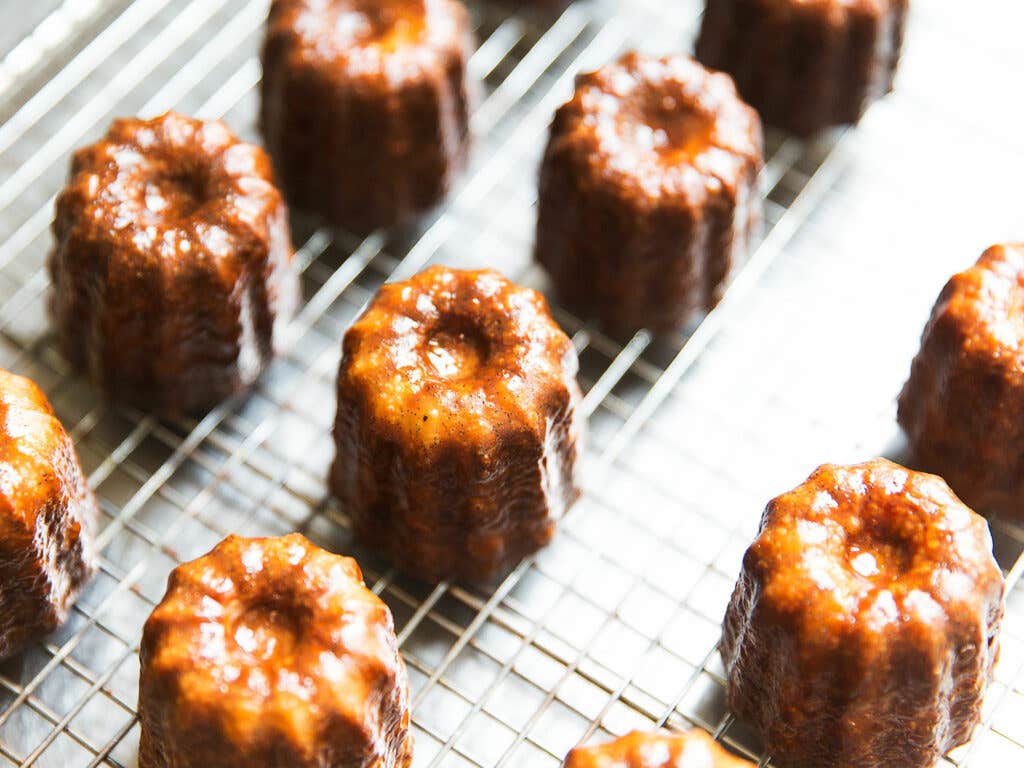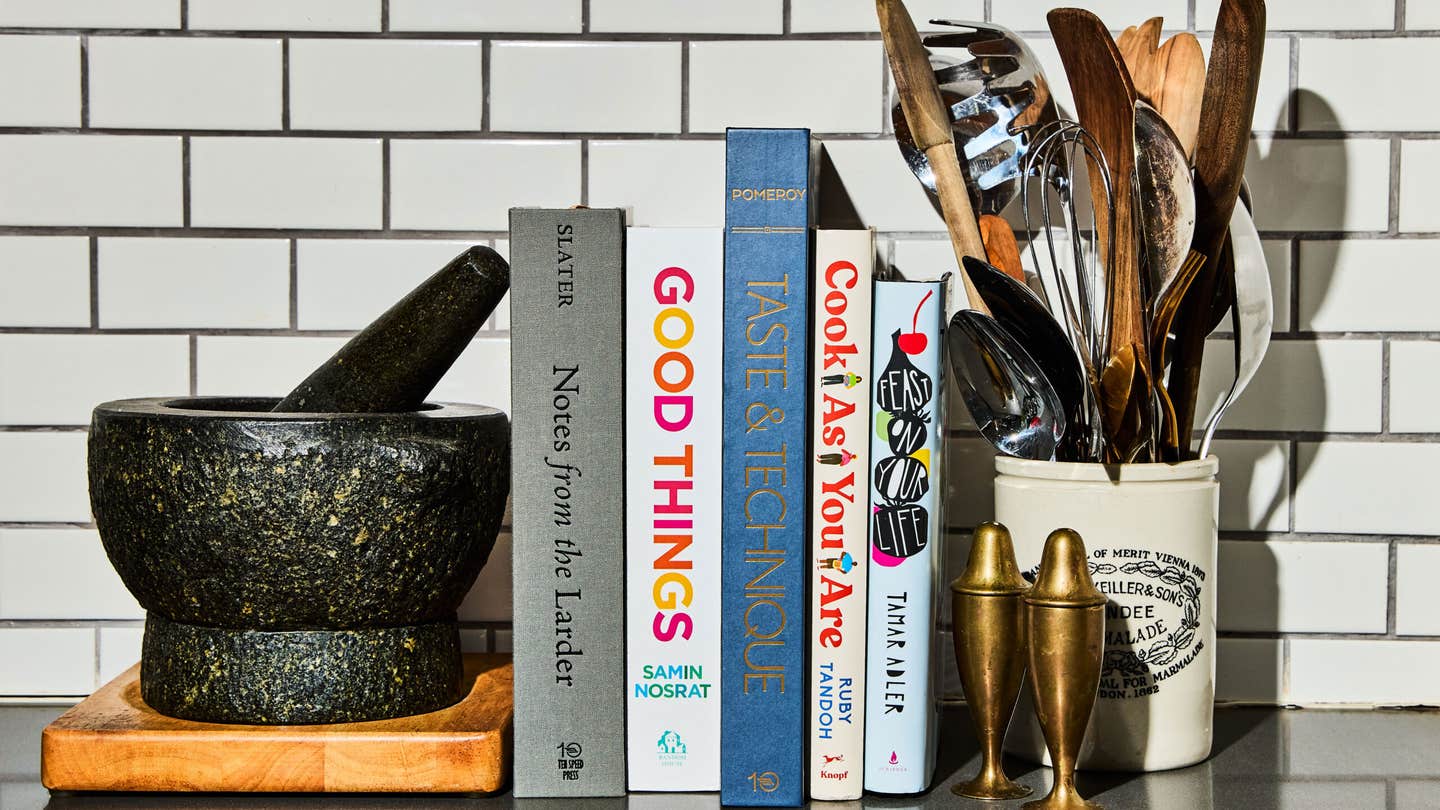
Diary of a Canelé Obsessive: The Decades-Long Quest to Bake the Perfect French Pastry
How to make caramel-crusted, custard-soft, ridiculously aromatic sweet pride of Bordeaux
During the summer of 1993, a friend and I biked some 600 miles from Paris to the Dordogne river region of France. Riding through small villages with no advance reservations meant that our mealtimes were unpredictable, so we kept hunger at bay the French way: by picking up snacks at whatever boulangerie or patisserie crossed our paths. Our nylon bags, stuffed with baguettes and pain au chocolat, left a scent trail of butter and chocolate through the wind.
The farther south we went, the more rural the landscape became, and the more peculiar the pastries we encountered. In Poitou, for instance, we laid into tourteau de fromage, a cake made from goat cheese with a blackened sugar top. And in Bordeaux, along with our usual staples, we picked up a couple of weird little sweets not much larger than eggs. They looked like miniature bundt cakes. My main impression at the time was that we should have bought more, because they were delicious, then gone in a bite or two.
It was 17 years before I saw the pastry again, in New York at Le Bernardin. After being dazzled by violet-hued sour cherry spheres and other works of science made by then-executive pastry chef Michael Laiskonis, some petit fours arrived. But the thimble-sized cake that appeared on the plate next to some macarons didn’t fully register. Like a long-time happily married couple who recall that their first two dates were just okay—that was me and canelé.
“Hold it in one hand and take a big bite out of it like an apple,” Dominique Ansel instructed me back in 2011, shortly before opening his Soho bakery. This, he said, was the best way to experience the sublime contrast between the deeply caramelized crust and soft custard-like interior of a canelé.
Ansel pointed to the tiny specks of Tahitian vanilla bean and urged me to inhale the sweet aroma, noting the hints of dark rum. I inhaled. I opened wide. I crunched. And I got it.
Canelés are textural masterpieces. The burnished crust—lacquered with butter and, traditionally, beeswax—crackles like the outer crumb of a fresh baguette, the torched sugar coating on crème brulee, or the burnt corner slice of brownie. The creamy insides are the most delicate custard, luxurious like pastry cream but with a fine porosity. The aromas of egg, vanilla, and rum are unmistakable.
Maybe I was also subconsciously transported back to my carefree 20s and that bucolic bike tour through France. All I knew for certain was that I felt a connection with this pastry.
“I love canelés,” said Laiskonis, now creative director at the Institute for Culinary Education, when I asked him about the pastry. He recounted some feedback he received from Le Bernardin co-founder Maguy Le Coze that helped him understand how such a simple pastry could be so special.
During a tasting, Laiskonis presented Le Coze with some forward-thinking petit fours, and she told him she liked them. But, she demurred, “the final bite the guest takes at the table should represent a reward after the meal, after the more complex dessert courses. We shouldn't force them to think beyond pure enjoyment.”
Laskonis explained that “adding the canelé to the repertoire fit that guidance, because you don't need to think about it beyond how delicious it is. That was a huge insight and a lesson I still call upon.”
This is the magic of canelé: dessert concentrated to its essence. And I had to know how to capture it.
Canelés are made with just a few simple ingredients: flour, sugar, milk, eggs, rum, and vanilla. But even more than most French food, virtually every aspect about how to make them is up for debate.
What people disagree about: The mixing order, integration method, and temperature of the ingredients; whether to use egg yolks or half yolks and half complete eggs; the proper granularity of the sugar; how long to rest the batter; how hot and for how long to bake them; the best mold material; whether to use butter, Pam, beeswax, or some combination of these to coat the molds; and whether to unmold immediately or wait until the baked pastry has cooled.
What people agree about: Use rum, vanilla and whole milk.
The molds are a particular sticking point. The caramelized-sugar crust of the best canelés comes from the heat conductivity of copper molds, and purists say you simply must commit to the expense of copper. Third-generation pastry chef Francois Payard puts it bluntly: “You can't make a true canelé in a silicone mold. It's a bastard canelé.”
Enabling my burgeoning canelé obsession, my wife bought me a couple of Matfer copper tin-lined canelé molds as an anniversary present, and after buying some beeswax on Amazon, I was anxious to dive in and start baking.
I began with a recipe by Pim Techamuanvivit of Chez Pim. Pim, who now runs a popular Thai restaurant in San Francisco, published in 2011 one of earliest and most thorough treatises on the myriad pitfalls of canelé baking: nearly 5,000 words of pastry exegesis in pursuit of perfection.
My first attempts with Pim’s recipe resulted in just enough success—perfectly infused vanilla and rum flavors and an apartment scented with cooked sugar—to keep my canelé compulsion alive. But there were issues. During baking, my canelés didn’t just rise a little out of their molds like they were supposed to; they ballooned like soufflés beyond the point of recovery. And although the crust was a pleasing deep mahogany color, it tasted slightly burnt or bitter.
It was a start. But I had work to do.
By this time I was writing regularly about dessert and pastry in New York, and had a network of pastry chefs that were delighted—perhaps with a hint of Schadenfreude—to learn that I was undertaking the canelé, and happy to offer crumbs of advice to a struggling baker.
Bosie Tea Parlor’s Damien Herrgott bakes one of the best canelé in New York, so I approached him about my unwieldy, swelling batter. “I don’t know why so many recipes call for confectioners sugar!” he exclaimed, noting that the cornstarch in the mix can exaggerate a batter’s puff. “Use standard granulated instead.” I did, and the canelé began to behave.
I asked Shawn Gawle, the three-Michelin-starred pastry chef now at Quince in San Francisco, about the displeasing burnt taste. Gawle, who served me an outstanding canelé as part of the petit fours at Corton in New York, suggested using clarified instead of standard butter with my beeswax, because it has a much higher burning point (400 degrees Fahrenheit versus regular butter’s 250). Not only did the bitterness disappear, but my canelés took on a perfect sheen as if they were dunked in shellac.
After overcoming these hurdles, my canelé looked and tasted pretty pro. But there was one more test I needed to pass. Early on, when I expressed my desire to bake the perfect canelé to Dominique Ansel, he smiled and said, “bring it to me when you’re done.” So, against my wife’s advice, and after nearly two years and dozens of batches later, I presented the chef with the fruits of my labor. Ansel did a quick examination, took a bite, and nodded.
“A bit sweet.”
Then he joked, “want a job?”
I’ve since cut back on the sugar a hair and the resulting canelés are, if I do say so myself, pretty close to the Bordeaux standard.
Triumph is sweet. And the botched batches along the way weren’t half bad either.
A Word About Molds

If you're beginning a canelé journey of your own, start with silicone molds. To be clear, they won't yield pastries with the deeply caramelized crust of copper, but will also only cost around $15, versus the $230 or so for eight copper ones. If you find yourself bitten by the canelé bug, go ahead and treat yourself. Matfer and Mauviel are both made in France, are well regarded, and will last for generations. Matfer offers a slightly smaller mold that holds about 62 grams of batter. The slightly more industrial strength Mauviel holds about 72 grams of batter and yields a larger canele.
And another budget option: In the last few months, an American mold manufacturer has appeared on Amazon selling four copper molds for a total of $50, a big discount over the French ones. I haven't personally used them, but the initial reviews seem promising.
Wear a Coat—But a Thin One
Whether you’re using copper or silicone molds, a swipe of softened butter or even some cooking spray will make for perfectly fine canelés. But for the glossiest finish and best flavor, coat the interiors with a 50/50 mix of beeswax (which incidentally adds a nice honeyed note) and clarified butter.
But the coating should be thin so the batter keeps in contact with the molds. To help this along, heat the molds until hot to the touch and cool them open-end-down so the excess can drain way.
Get Your Rest
After mixing your ingredients but before filling your molds and baking your canelé, you must rest the batter for at least 24 hours. This allows the flour to properly hydrate and for the gluten to develop, ensuring that your canele keep their shape when they rise out of the molds during baking. The rest also allows the rum and vanilla to fully permeate the batter. I recommend 48 to 72 hours, because the longer the rest, the stronger the rum and vanilla flavor in the canelé.

Keep Reading
Continue to Next Story










